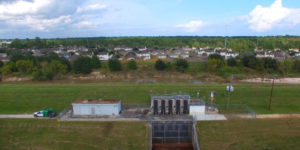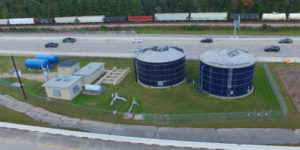Water & Sewer
About the System
The District’s water and wastewater facilities are professionally maintained and operated by H2O Innovation The operator for Inverness Forest Improvement District, H2O Innovation, works to ensure the highest quality services and complies with all state and federal rules and requirements. All of the District’s facilities have been equipped with backup power generators to ensure that the water and sewer services will continue even if there is a loss of power.
All wells, water plants, wastewater treatment, and stormwater facilities are owned by Inverness Forest Improvement District. Inverness Forest ID is subject to the North Harris County Regional Water Authority’s Groundwater Reduction Plan and incurs fees for groundwater pumped from wells located within the District. These fees incurred by Inverness Forest ID are passed on the residents as a separate line item on their bills.

Operator
H2O Innovation
27335 West Hardy Rd. Suite 101
Spring, Tx 77373
Customer Care/Billing Hours
Monday- Friday: 8:00 a.m.- 4:15 p.m.
Phone: (281) 353-9756
Email: Service.US@H2OInnovation.com
Emergency 24 hour service line: (281) 353-9809

Water Conservation
- Check your toilet for leaks. Put a little food coloring into your toilet tank and let it sit for 15 minutes. If the color appears in the bowl without flushing, you have a leak that should be repaired immediately. A leaky toilet can waste as much as 200 gallons of water per day.
- Bathroom facilities claim nearly 75% of the indoor water used. An ultra-flow flush toilet can cut your family’s total indoor water use by as much as 20%.
- Try showering the “Navy Way”. Just get wet, turn off the shower while soaping up and scrubbing, and turn it back on briefly to rinse off. Super low-flow showerheads can be installed to deliver as little as 1.25 gallons per minute, as opposed to the standard 3.2 gallons.
- Don’t use your toilet as a garbage can; put dirty tissues, napkins or paper towels in the wastebasket.
- Check your sink, lavatory and shower faucets for leaks. A dripping faucet can waste up to 2,000 gallons of water a year. Install sink aerators to reduce the flow of water. You could save up to 240 gallons per month!
- Turn off the faucet. This may sound simple, but gallons of water are wasted daily while people wash dishes, clean vegetables, shave and brush their teeth.
- When you rinse off vegetables and fruits, plug up the sink instead of using running water.
- Plug up the sink when you wash dishes by hand, as well. When you’re finished, turn on the garbage disposal as you pull the plug.
- Keep a bottle of drinking water in the refrigerator. Allowing the faucet to run until the water feels cool wastes water.
- Every glass of water brought to your table in a restaurant requires another two glasses of water to wash and rinse the glass. Since 70 million meals are served each day in the U.S. restaurants, we would save more than 26 million gallons of water if only one person in four declined the complimentary glassful.
- Select the appropriate water level for the size of the load of laundry. Most washers now offer preset water levels for small, medium and large loads. Wait until you have a full load of clothes before you run the washing machine whenever possible.
- Maximize appliance efficiency by making sure dishwashers and clothes washers are fully loaded before starting them. Do this and you can save another 15 gallons per load for dishwashers or 55 gallons per load for clothes washers.
- Approximately 50-70% of household water is used outdoors for watering lawns and gardens, so make the most of the water you use. Never water during the hottest times of the day or when it’s windy. Turn off your automatic sprinklers when it’s raining. By planting grasses and shrubs that use little water, you can reduce your watering by up to 50%.
- If you have a fish tank, use the dirty water from the tank on your houseplants. It’s rich in nitrogen and phosphorus, which gives you a good fertilizer.
- When landscaping, use plants that require little water. You can decorate creatively with interesting objects that need no water at all, such as rocks, bricks, benches, gravel, and deck areas. Watering and other outside irrigation can use as much as 75 – 80% of all of your water consumed.
- Water lawns and gardens once a week. They only need 2.5 centimeters of water a week, including rainfall. Avoid watering on windy days. Water early in the morning for best results. Early-morning watering is also the best way to avoid the peak-demand periods.
- Be careful to water only the lawn or garden, not the street or sidewalk. Instead of letting the water run when you wash your car, wet the car thoroughly, then turn off the hose while you wash with soapy water from a bucket. Use the hose again for a final rinse. A trigger nozzle is best because it turns off automatically.
- Hosing down your driveway for 5 minutes wastes 25 gallons of water. Clean it with a broom or blower instead.
- In the winter, avoid the risk of frozen water pipes that can burst. Eliminate drafts in your home and insulate pipes with insulation wraps that can be easily purchased at your local hardware or home store. It’s also a good idea to locate and tag your water shut-off valve so you can find it quickly in an emergency. Also, make sure your meter cover is in good condition. Please contact our service center at 281 353-9809 if your meter cover needs attention.
- If you have a pool, cover it. Evaporation can make hundreds, even thousands of gallons of water disappear. Covering the pool will cut the loss by 90%.